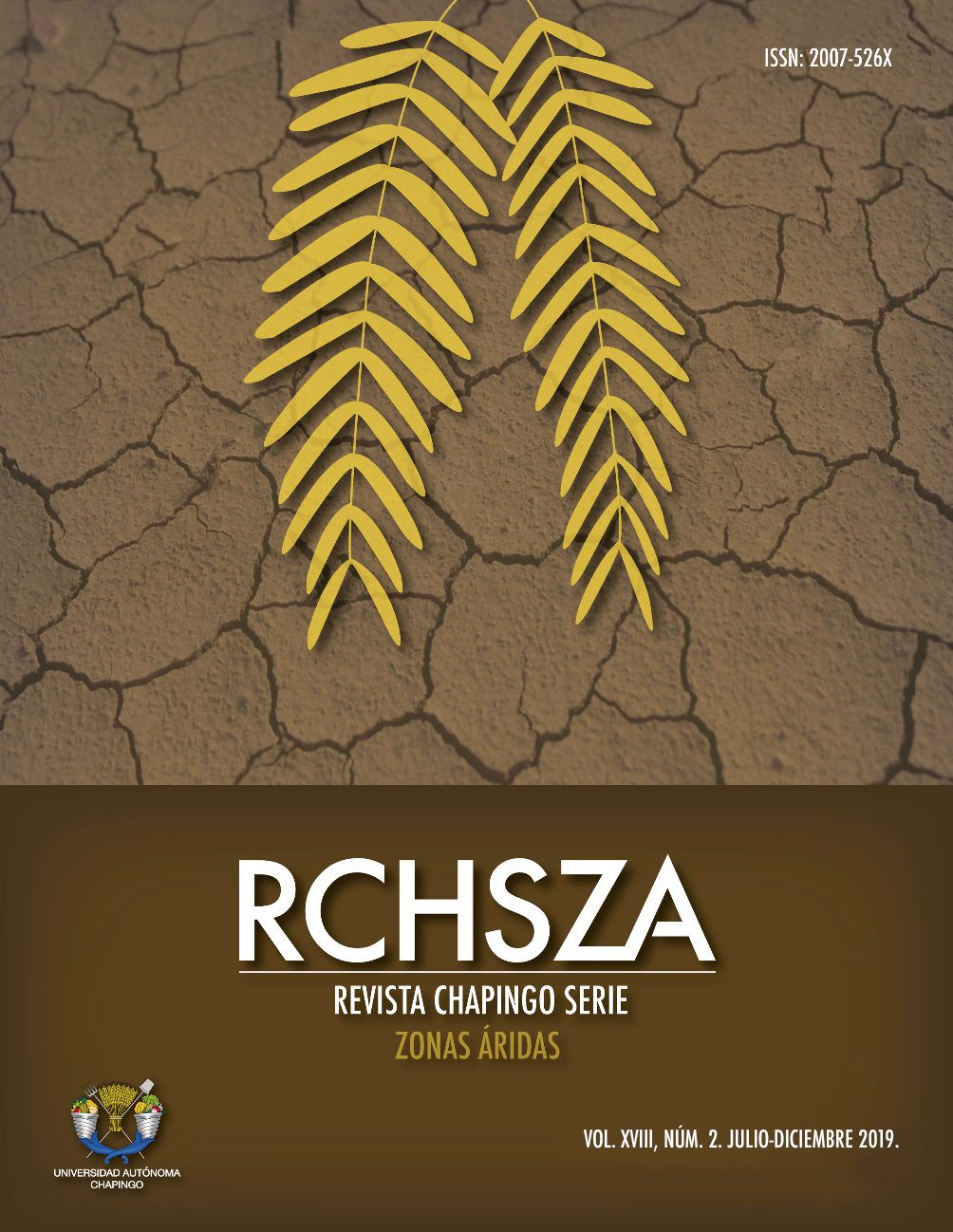Resumen
La identificación del efecto de dietas integrales con la adición de biomasa del arbusto de gobernadora (Larrea tridentata) como forraje para borregos sobre el consumo de alimento, ganancia de peso, pH, protozoarios ruminales y, concentración de ooquistes de Eimeria spp. en heces, fue el objetivo de este trabajo. Se incorporó como forraje la planta completa de gobernadora en 0 (testigo), 5 y 10 % (base seca) en dietas integrales en sustitución de paja de sorgo. Las dietas fueron asignadas aleatoriamente a 21 borregos Rambouillet (22.1 ± 1.7 kg de peso vivo). El ensayo tuvo una duración de 60 días. Los borregos alimentados con 5 y 10 % de gobernadora tuvieron menor (P<0.04) consumo que el testigo. Ganancia de peso, eficiencia alimentaria y pH ruminal tienen valores con diferencias no significativas. El recuento de protozoarios ruminales y de ooquistes en heces fueron disminuidos (P<0.02) conforme se incrementó el porcentaje de gobernadora en la dieta. Por lo tanto, los resultados indican que es factible utilizar hasta el 10 % de biomasa de gobernadora en las dietas para borregos.
Citas
Aguirre-Joya, J. A., Pastrana-Castro, L., Nieto-Oropeza, D., Ventura-Sobrevilla, J., Roja s-Molina, R., & Aguilar, C. N. (2018). The physicochemical, antifungal and antioxidant properties of a mixed polyphenol based bioactive film. Heliyon 4, e00942. doi: https://doi.org/10.1016/j.heliyon.2018.e00942.
AOAC (2006). Official Methods of Analysis. 18th edition. Association of Official Analytical Chemists, Washington, DC, USA. https://www.aoac.org
Arteaga, S., Andrade-Cetto, A., & Cárdenas, R. (2005). Larrea tridentata (Creosote bush), an abundant plant of Mexican and US-American deserts and its metabolite nordihydroguaiaretic acid. Journal of Ethnopharmacology, 98, 231-239. doi: https://doi.org/10.1016/j.jep.2005.02.002
Bashyal, B., Li, L., Bains, T., Debnath, A., & LaBarbera, D. V. (2017). Larrea tridentata: A novel source for anti- parasitic agents active against Entamoeba histolytica, Giardia lamblia and Naegleria fowleri. PLoS Neglected Tropical Diseases, 11(8), e0005832. doi: https://doi.org/10.1371/journal.pntd.0005832
De Melo, G. O., Malvar, D. C., Vanderlinde, F. A., Rocha, F. F., Pires, P. A., Costa, S. S. (2009). Antinociceptive and anti-inflammatory kaempferol glycosides from Sedum dendroideum. Journal of Ethnopharmacology, 124(2), 228-232. https://doi.org/10.1016/j.jep.2009.04.024
Dehority, B. A. (1984). Evaluation of subsampling and fixation procedures used for counting rumen protozoa. Applied and Environmental Microbiology, 48(1), 182-185. https://www.ncbi.nlm.nih.gov/pmc/articles/PMC240360/
Duisberg, P. C. (1952). Development of a feed from the Creosote Bush and determination of its nutritive value. Journal of Animal Science, 11(1), 174-180. https://doi.org/10.2527/jas1952.111174x
Estell, R. E. (2010). Coping with shrub secondary metabolites by ruminants. Small Ruminant Research, 94, 1-9. doi: https://doi.org/10.1016/j.smallrumres.2010.09.012
Foreyt, W. J. (2001). Veterinary Parasitology Reference Manual. 5th ed. Blackwell Publishing Professional. Ames, Iowa, USA.
Garcia, J. E., Gómez, L., Mendoza-de-Gives, P., Rivera-Corona, J. L., Millán-Orozco J., Ascacio, J. A.,... & Mellado, M. (2018). Anthelmintic efficacy of hydro-methanolic extracts of Larrea tridentata against larvae of Haemonchus contortus. Tropical Animal Health and Production, 50, 1099-1105. doi: https://doi.org/10.1007/s11250-018-1535-5
Gnabre, J., Bates, R., & Chih Huang, R. (2015). Creosote bush lignans for human disease treatment and prevention: perspectives on combination therapy. Journal of Traditional and Complementary Medicine, 5, 119-126. http://dx.doi.org/10.1016/j.jtcme.2014.11.024
Gómez y González, A., Pinos Rodríguez, J. M., & Aguirre Rivera, J. R. (2009). Manual de Producción Caprina. Universidad Autónoma de San Luis Potosí, San Luis Potosí, S.L.P., México. ISBN 978-970-705-082-2
Guerrero-Cervantes, M., Ramírez, R. G., González-Rodríguez, H., Cerrillo-Soto, A., & Juárez-Reyes, A. (2012). Mineral content in range forages from north Mexico. Journal of Applied Animal Research, 40(2), 102-107. http://dx.doi.org/10.1080/09712119.2011.607907
Holechek, J. L., Munshikpu, A. V., Saiwana, L., Nunez Hernandez, G., Valdez, R., Cardenas, M. 1990. Influences of six shrub diets varying in phenol content on intake and nitrogen retention by goats. Tropical Grasslands 24: 93-98. https://www.cabdirect.org/cabdirect/abstract/19911439705.
Hwu, J. R., Hsu, M. H., & Huang, R. C. (2008). New nordihydroguaiaretic acid derivates as anti-HIV agents. Bioorganic & Medicinal Chemistry Letters, 18, 1884-1888. doi: https://doi.org/10.1016/j.bmcl.2008.02.018
Hyder, P. W., Fredrickson, E. L., Estell, R. E., Tellez, M., & Gibbens, R. P. (2002). Distribution and concentration of total phenolics, condensed tannins, and nordihydroguaiaretic acid (NDGA) in Creosote bush (Larrea tridentata). Biochemical Systematics and Ecology, 30(10), 905-912, https://doi.org/10.1016/S0305-1978(02)00050-9.
Jitsuno, M., & Mimaki, Y. (2010). Triterpene glycosides from the aerial parts of Larrea tridentata. Phytochemistry, 71, 2157-2167. doi: https://doi.org/10.1016/j.phytochem.2010.09.012
Lodge-Ivey, S. L., Petersen, J., & Browne-Silva, J. (2012). Effects of nordihydroguaiaretic acid on in vitro fermentation profiles of rumen bacteria. Journal of Animal Science, 90, 4118-4125. doi: https://doi.org/10.2527/jas2012-5339
Luiselli Fernández, C. (2007). Agricultura y Alimentación en México: evolución, desempeño y perspectivas. México, Ciudad de México: Siglo XXI Editores. 475 p. e-isbn: 978-607-03-0985-4
Mellado, M., Rodríguez, A., Villarreal, J. A., Rodríguez, R., Salinas, J., & López, R. (2005). Gender and tooth wear effects on diets of grazing goats. Small Ruminant Research, 57(2-3), 105-114. https://doi.org/10.1016/j.smallrumres.2004.03.009
Mertens, D. R. (2002). Gravimetric determination of amylase-treated neutral detergent fibre in feeds with refluxing beakers or crucibles: collaborative study. Journal of the Association Official Analytical Chemists, 85, 1217-1240. https://pubag.nal.usda.gov/download/26403/PDF
NRC, (2007). Nutrient Requirement of Small Ruminants; Sheep, Goats, Cervids, and New World Camelids. The National Academic Press, Washington, D.C. USA. https://doi.org/10.17226/11654
NRC, (2001). Nutrient Requirements of Dairy Cattle, 7th Revised Edition. National Academy Press, Washington D.C: USA. https://doi.org/10.17226/9825
SAS, Statistical Analysis System. (2002). SAS/STAT 9 User’s Guide. Carry, NC, USA: SAS Institute Inc.
Schmidt, T. J., Rzeppa, S., Kaiser, M., & Brun, R. (2012). Larrea tridentata – Absolute configuration of its epoxylignans and investigations on its antiprotozoal activity. Phytochemistry Letters, 5, 632-638. http://dx.doi.org/10.1016/j.phytol.2012.06.011
Skouta, R., Morán-Santibañez, K., Valenzuela, C. A., Vasquez, A. H., & Fenelon, K. (2018). Assessing the antioxidant properties of Larrea tridentata extract as a potential molecular therapy against oxidative stress. Molecules, 23, 1826. doi: https://doi.org/10.3390/molecules23071826
Villalobos,V.M.,GarcíaM.,&Ávila,F.(2017).ElAguapara la Agricultura de las Américas. IICA y Fundación COLPOS. San José, Costa Rica. ISBN: 978-92-9248-700-3. https://www.Iica.int

Esta obra está bajo una licencia internacional Creative Commons Atribución-NoComercial 4.0.
Derechos de autor 2019 Revista Chapingo Serie Zonas Áridas



